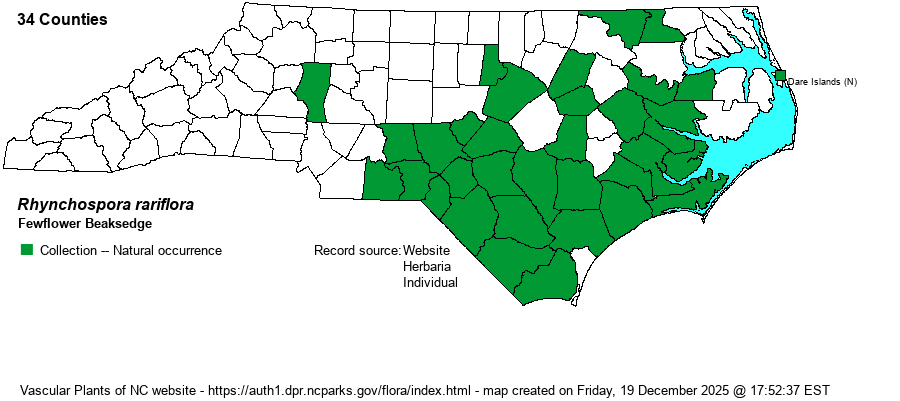| Author | (Michaux) Elliott | |
| Distribution | Coastal Plain, Sandhills, and lowermost Piedmont. Disjunct in Iredell County: bog 3.2 miles W of Harmony in 1947 (now historical). The Outer Banks record is from Roanoke Island.
NJ, TN, and OK south to FL and TX; West Indies, Central America. | |
| Abundance | Frequent in the Coastal Plain and Sandhills, though scarce in parts of the northern Coastal Plain (where clearly under-collected); rare in the Piedmont and Outer Banks. | |
| Habitat | Pitcher-plant seepages, Piedmont bogs, blackwater streamhead ecotones, Sandhills seeps, wet pine savannas. |
| Phenology | Flowering and fruiting July-September. | |
| Identification | This species is clump-forming or tussock-forming, with threadlike leaves and lazy stems. The inflorescences are open, and each branch supports 1-3 flowers/fruits. It is reminiscent of R. oligantha and R. galeana, but the seed bristles are not feathery. It is much like R. stenophylla, but R. rariflora bristles are no longer than the seed body, versus longer than the seed beak in R. stenophylla. | |
| Taxonomic Comments | None
Members of the genus Rhynchospora -- mainly called beaksedges but also called beakrushes -- are mostly Coastal Plain in distribution and are important members of our longleaf pine savannas, flatwoods, streamheads, depression ponds, Carolina bays, and beaver ponds. They vary from small and wiry to large and coarse. Keys concentrate on features of the achenes (seeds) and the shape and arrangement of the flower clusters (spikelets). The seeds may or not have bristles at their base; bristle number, length, and toothing are critical characters. Size and shape of the seed beaks is also critical. The drawings in Godfrey & Wooten (1979) are extremely helpful. The genus now includes Dichromena, the white-topped sedges. | |
| Other Common Name(s) | None | |
| State Rank | S4? [S4] | |
| Global Rank | G5 | |
| State Status | | |
| US Status | | |
| USACE-agcp | OBL link |
| USACE-emp | OBL link |

